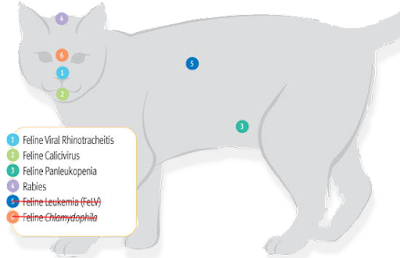Vaccination for cats & Kittens
Veterinarians, from all over the world, have divided vaccines into two type, one is core vaccines and other is non-core vaccines. There are many vaccines advised for cats and they are administered with different schedules. Core vaccines in cats are vaccines which are considered very important to administer in all cats and in all regions of the world. And all veterinarians consider it mandatory to vaccinate the cats with core vaccines.
 |
| core vaccines for cats |
Core Vaccines for Cats:
- Feline Panleukopenia
- Feline Rhinotracheitis
- Feline Calcivirus
- Rabies
1- Feline Panleukopenia:
Feline Panleukopenia is caused by Feline Parvovirus, a virus from the family of Canine Parvovirus. Feline Panleukopenia is also known as feline distemper and Feline infectious enteritis. It’s more common in kitten of two to six month of age, in pregnant cats and in immuno-compromised adult cats.
Early signs of the disease are:
- High fever (105 F)(40 C)
- Loss of apitite
- Vomiting
- Diarrhoea
The virus transmit from wild cats, ferrets, minks and raccoons. Previously infected but recovered cats also shed virus for many days. The infected cat is given supportive therapy and it may take 1-2 weeks to recover cat. Vaccination is very important for prevention.
2- Feline Rhinotracheitis:
Feline Viral Rhinotracheitis (FVR) is the infection of upper respiratory tract, nose, throat & eyes, in cats. It is caused by a DNA Virus, Feline Herpers Virus Type-1. The virus affects the cats of all ages but it’s more common in kittens and old cats. The virus spreads more common in very congested environment and where large number of cats live together. Poor nutrition, poor environment and poor nutrition are also some disease provoking factors.
Cats don’t show any sign of disease for many days & they can spread virus to other cats without any notification. The incubation period is 2-5 days.
Common signs of the disease are:
- Nasal Discharge
- Conjunctivitis (Inflammation of conjunctiva) & Keratitis
- Sneezing
- Loss of apatite
- Pregnant cats may abort due to this infection
The virus transmits to the other healthy cats via sneezing and aerosol. Human hand and clothes can also transfer virus.
IT IS ALSO NOTICED THAT 10% OF RECOVERED CATS BECOME ASYMPTOMATIC CARRIERS.
The disease can be treated with Broad Spectrum Antibiotics and good nutritional and fluid therapy. Ophthalmic medications and eye drops can be suggested to cure eye infections. Overall therapy for viral disease is supportive medication to stop further infections.
Feline Viral Rinotracheitis can be controlled by minimising the interaction of cat with other infected and wild cats. Infected cat should be separated from healthy cats and it should be given and calm and good place for resting to avoid further stress.
Vaccination is very important to avoid exposure of virus in kittens. Vaccination is usually done according to the commonly accepted vaccination schedule in cats.
3- Feline Calcivirus Infection:
Feline Calcivirus Infection is actually infection of upper respiratory tract, nose, mouth, throat and eyes. This infection may also reach to lungs, ulceration in lungs, and musculoskeletol systems. The may develop flu-like symptoms and nasal & occular discharge can be easily seen.
The infection is caused by virus called Feline Calcivirus and it is found all over the world. Virus infects all ages of cats but young and un-vaccinated cats are more susceptible to infections. There are almost 40 strains of the virus and the signs and symptoms of disease vary with the different strains.
One very virulent strain, know as “Virulent Systemic Feline Calicivirus or VS-FCV“, causes generalized systemic infection and mortality rate may go up-to 67%.
The incubation period of this disease is 5-7 days and after incubation periods signs of disease can be easily seen. Clinical signs of Feline Calcivirus Infection (FCV) are:
- Nasal Discharge
- Ocular Discharge (Discharge from Eye)
- Development of ulcers on tongue, plate, nose, lips and hooves.
- Inflammation of gums.
- Loss of appetite
- Pneumonia
- Arthritis & pain in joints
EACH CAT INFECTED WITH FELINE CALCIVIRUS INFECTION OFTEN DEVELOP ULCERS.
Diagnosis of Feline Calcivirus don’t need very specific test for most of the cases and Upper-Respiratory Tract Infection (URI) is one typical sign of this disease. In other complex situations a swab from gums and plate is tested by RT-PCR for virus.
FCV can be treated with Broad-Spectrum Antibiotics and supportive therapy is done.
Feline CalciVirus transfer from nasal and ocular discharge of the cats. Infected cats sheds virus upto 50-75 days after recovery. Poor nutrition, poor ventilation and poor management conditions may promote the infection chances.
Feline Calcivirus can be prevented with vaccination. Veterinarians recommends to follow the vaccination schedules strictly for all vaccines.
Rabies:
4TH, LAST BUT NOT THE LEAST, CORE DISEASE IN WILD AND DOMESTIC CATS IS RABIES. IT’S ALSO A ZOONOTIC DISEASE AND CAN BE TRANFER TO HUMAN. IT’S OMMON IN MORE THAN 150 COUNTRIES OF THE WORLD.
Rabies is caused by a genus virus know as lyssa virus. It a member of Rhabdoviridae family of this genus. The virus affects the nervous system and animals become mad, in most cases.
Particular signs and symptoms of Rabies are:
- Pica
- Fever
- Seizures
- Paralysis
- Hydrophobia
- Jaw is dropped
- Inability to swallow
- Change in tone of bark
- Muscular lack of coordination
- Unusual shyness or aggression
- Excessive excitability
- Constant irritability/changes in attitude and behavior
- Paralysis in the mandible and larynx
- Excessive salivation (hyper-salivation), or frothy saliva
Vaccination is the best preventative measure to control rabies and this disease totally preventable.
